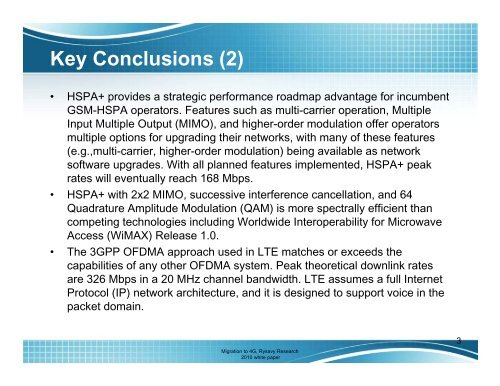Presentation slides for this white paper - 4G Americas
Presentation slides for this white paper - 4G Americas
Presentation slides for this white paper - 4G Americas
You also want an ePaper? Increase the reach of your titles
YUMPU automatically turns print PDFs into web optimized ePapers that Google loves.
Key Conclusions (2)• HSPA+ provides a strategic per<strong>for</strong>mance roadmap advantage <strong>for</strong> incumbentGSM-HSPA operators. Features such as multi-carrier operation, MultipleInput Multiple l Output t (MIMO), and higher-order h modulation offer operatorsmultiple options <strong>for</strong> upgrading their networks, with many of these features(e.g.,multi-carrier, higher-order modulation) being available as networksoftware upgrades. With all planned features es implemented, e ed, HSPA+ peakrates will eventually reach 168 Mbps.• HSPA+ with 2x2 MIMO, successive interference cancellation, and 64Quadrature Amplitude Modulation (QAM) is more spectrally efficient thancompeting technologies including Worldwide Interoperability <strong>for</strong> MicrowaveAccess (WiMAX) Release 1.0.• The 3GPP OFDMA approach used in LTE matches or exceeds thecapabilities of any other OFDMA system. Peak theoretical downlink ratesare 326 Mbps in a 20 MHz channel bandwidth. LTE assumes a full InternetProtocol (IP) network architecture, and it is designed to support voice in thepacket domain.Migration to <strong>4G</strong>, Rysavy Research2010 <strong>white</strong> <strong>paper</strong>3
















